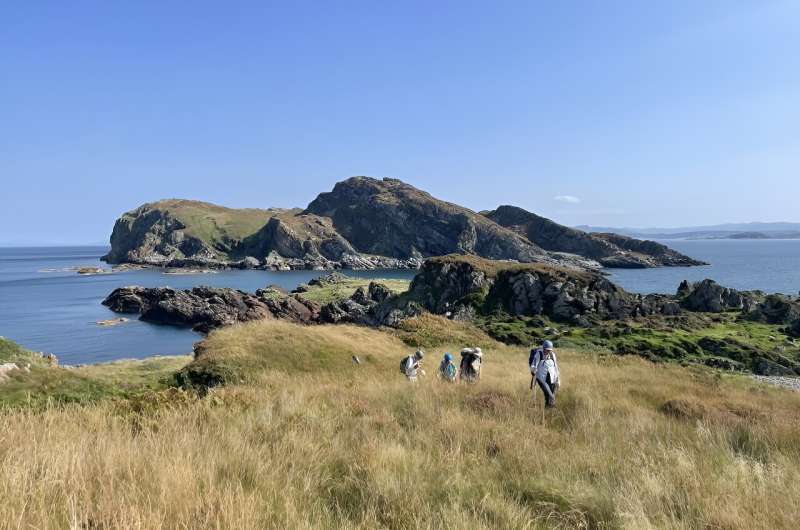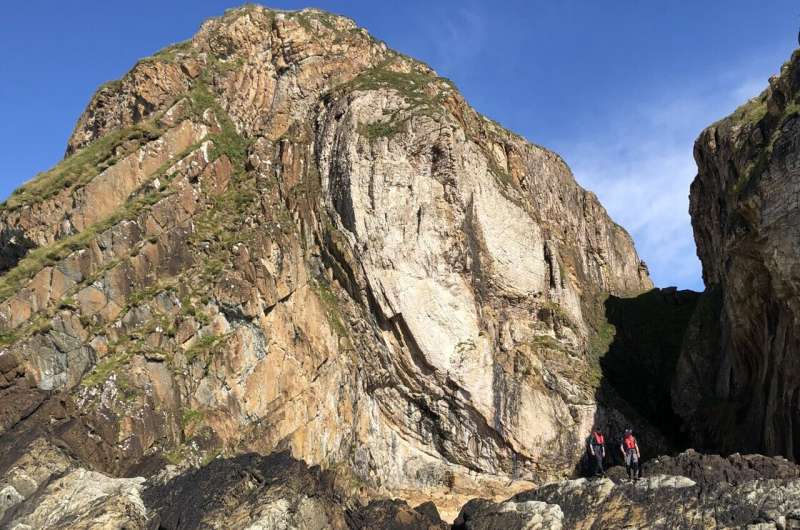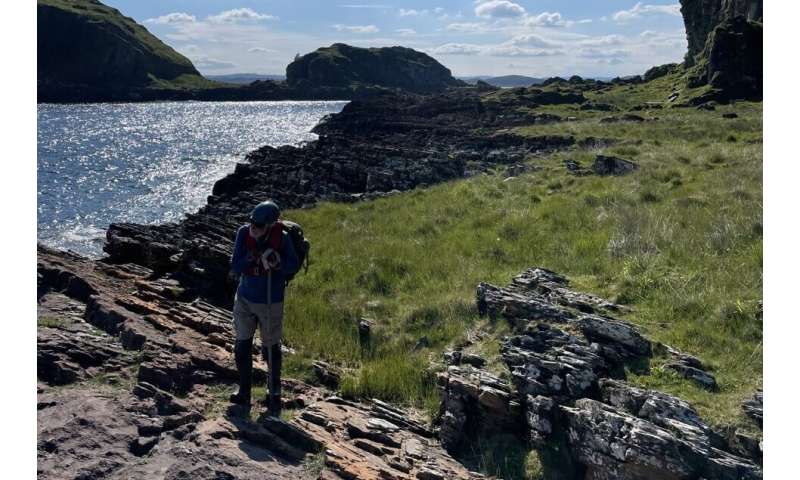This article has been reviewed according to Science X's editorial process and policies. Editors have highlighted the following attributes while ensuring the content's credibility:
fact-checked
trusted source
proofread
Scottish and Irish rocks confirmed as rare record of 'snowball Earth'

A rock formation spanning Ireland and Scotland may be the world's most complete record of "snowball Earth," a crucial moment in planetary history when the globe was covered in ice, finds a new study led by UCL (University College London) researchers.
The study, published in the Journal of the Geological Society of London, found that the Port Askaig Formation, composed of layers of rock up to 1.1km thick, was likely laid down between 662 to 720 million years ago during the Sturtian glaciation—the first of two global freezes thought to have triggered the development of complex, multicellular life.
One exposed outcrop of the formation, found on Scottish islands called the Garvellachs, is unique as it shows the transition into "snowball Earth" from a previously warm, tropical environment.
Other rocks that formed at a similar time, for instance in North America and Namibia, are missing this transition.
Senior author Professor Graham Shields, of UCL Earth Sciences, said, "These rocks record a time when Earth was covered in ice. All complex, multicellular life, such as animals, arose out of this deep freeze, with the first evidence in the fossil record appearing shortly after the planet thawed."
First author Elias Rugen, a Ph.D. candidate at UCL Earth Sciences, said, "Our study provides the first conclusive age constraints for these Scottish and Irish rocks, confirming their global significance.

"The layers of rock exposed on the Garvellachs are globally unique. Underneath the rocks laid down during the unimaginable cold of the Sturtian glaciation are 70 meters of older carbonate rocks formed in tropical waters. These layers record a tropical marine environment with flourishing cyanobacterial life that gradually became cooler, marking the end of a billion years or so of a temperate climate on Earth.
"Most areas of the world are missing this remarkable transition because the ancient glaciers scraped and eroded away the rocks underneath, but in Scotland by some miracle the transition can be seen."
The Sturtian glaciation lasted approximately 60 million years and was one of two big freezes that occurred during the Cryogenian Period (between 635 and 720 million years ago). For billions of years prior to this period, life consisted only of single-celled organisms and algae.
After this period, complex life emerged rapidly, in geologic terms, with most animals today similar in fundamental ways to the types of life forms that evolved more than 500 million years ago.
One theory is that the hostile nature of the extreme cold may have prompted the emergence of altruism, with single-celled organisms learning to co-operate with each other, forming multicellular life.
The advance and retreat of the ice across the planet was thought to have happened relatively quickly, over thousands of years, because of the albedo effect—that is, the more ice there is, the more sunlight is reflected back into space, and vice versa.
Professor Shields explained, "The retreat of the ice would have been catastrophic. Life had been used to tens of millions of years of deep freeze. As soon as the world warmed up, all of life would have had to compete in an arms race to adapt. Whatever survived were the ancestors of all animals."
-

Co-author Anthony (Tony) Spencer standing on the Garbh Eileach Formation. The rocks record a gradual transition from the warm tropical world of the Tonian period into the snowball Earth of the Cryogenian period. Credit: Elias Rugen -

Standing on limestone beds of the pre-glacial Garvellach Formation, looking North from Garbh Eileach over to Dun Chonnuil. Due to tectonic tilting, the sedimentary layers get younger, and closer to the onset of glaciation, as you move to the right. Credit: Elias Rugen
For the new study, the research team collected samples of sandstone from the 1.1km-thick Port Askaig Formation as well as from the older, 70-meter thick Garbh Eileach Formation underneath.
They analyzed tiny, extremely durable minerals in the rock called zircons. These can be precisely dated as they contain the radioactive element uranium, which converts (decays) to lead at a steady rate. The zircons together with other geochemical evidence suggest the rocks were deposited between 662 and 720 million years ago.
The researchers said the new age constraints for the rocks may provide the evidence needed for the site to be declared as a marker for the start of the Cryogenian Period.
This marker, known as a Global Boundary Stratotype Section and Point (GSSP), is sometimes referred to as a golden spike, as a gold spike is driven into the rock to mark the boundary.
GSSPs attract visitors from around the world and in some cases museums have been established at the sites.
A group from the International Commission on Stratigraphy, a part of the International Union of Geological Sciences, visited the Garvellachs in July to assess the case for a golden spike on the archipelago. Currently, the islands are only accessible by chartering a boat or by sailing or kayaking to them.
The study involved researchers from UCL, the University of Milano-Bicocca, Italy, and Birkbeck University of London.
More information: Journal of the Geological Society of London (2024). DOI: 10.1144/jgs2024-029. www.lyellcollection.org/doi/fu … /10.1144/jgs2024-029
Provided by University College London




















